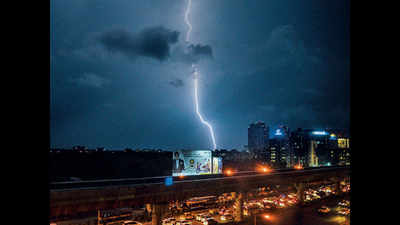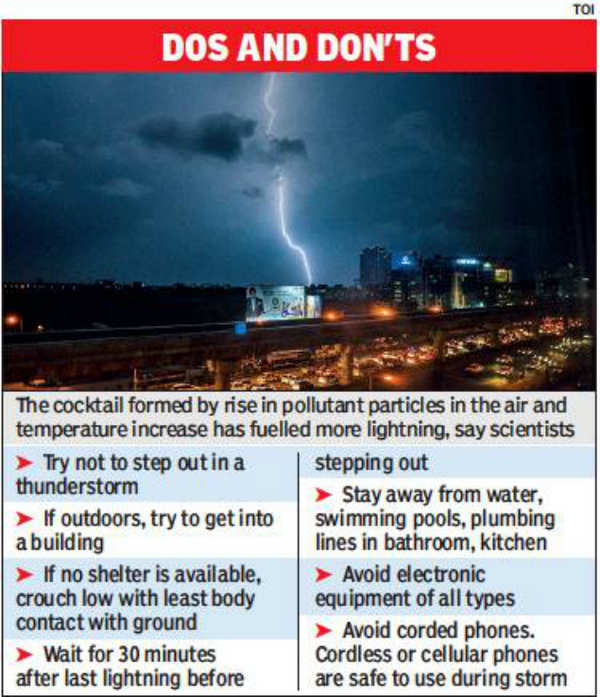- News
- City News
- kolkata News
- Kolkata: Pollution rise triggers fatal lightning strikes
Trending
This story is from August 17, 2019
Kolkata: Pollution rise triggers fatal lightning strikes
Atmospheric scientists and researchers warn of more fatalities from lightning strikes if urgent measures are not taken to curb air pollution.

The cocktail formed by rise in pollutant particles in the air and temperature increase has fuelled more lightning, say scientists
KOLKATA: Atmospheric scientists and researchers warn of more fatalities from lightning strikes if urgent measures are not taken to curb air pollution.

“There is a direct correlation between fatal lightning strikes and pollution rise. Lightning is an electrical discharge caused by imbalances between storm clouds and the ground, or between clouds themselves. Most lightning occurs between clouds. Earlier, cities like Kolkata experienced only cloud-to-cloud lightning where one saw spectacular flashes and thunders but it did not cause any harm.But in recent years, the frequency of cloud-to-ground lightning in which the discharge causes deaths and damage has shot up. This is due to pollution,” said Anirban Middey, scientist with National Environment Engineering & Research Institute (NEERI) who has studied the pattern and behaviour of lightning.
Track the pollution level in your city
In the paper on reciprocal relation between lightning and pollution and their impact over Kolkata that she co-authored with Middey, Chaudhuri observes: “The higher SPM concentration over the surface contributes to more cloud condensation nuclei (small particles on which water vapour condenses). These result in the reduction of the mean cloud droplet size. Thus, more supercooled water is likely to exist at greater depths in clouds. The profusion of supercooled water may generate large graupel (snow pellets or soft hail). The net effect is an enhanced lightning activity over the urban regions.”
While increased incidence of lightning enhances the risk to life and property, Chaudhuri also points to the long-term adverse impact on the environment. “Lightning causes the production of nitrogen oxide in the atmosphere, which creates surface ozone through a photochemical reaction in the presence of sunlight. And while ozone is desirable in the stratosphere, it is not wanted in the troposphere, the atmospheric layer closest to us,” she explained.
Some scientists say increased urbanisation and consequent reduction in greenery have contributed to fatal lightning strikes.
Warming up of the city has also contributed to the high incidence of lightning. The Intergovernmental Panel on Climate Change (IPCC) report states that a rise of 1°C in earth’s surface temperature will lead to a 56% rise in lightning in the northern hemisphere. Kolkata has experienced a rise of more than 1°C in last 40 years.
Deaths due to lightning are higher in Maharashtra (mostly in Nagpur and Aurangabad), Odisha and West Bengal due to instability and moisture content in the air.

“There is a direct correlation between fatal lightning strikes and pollution rise. Lightning is an electrical discharge caused by imbalances between storm clouds and the ground, or between clouds themselves. Most lightning occurs between clouds. Earlier, cities like Kolkata experienced only cloud-to-cloud lightning where one saw spectacular flashes and thunders but it did not cause any harm.But in recent years, the frequency of cloud-to-ground lightning in which the discharge causes deaths and damage has shot up. This is due to pollution,” said Anirban Middey, scientist with National Environment Engineering & Research Institute (NEERI) who has studied the pattern and behaviour of lightning.
Track the pollution level in your city
According to scientists, the cocktail formed by rise in pollutant particles in the air and temperature increase has fuelled more lightning. “Suspended particulate matter in Kolkata has shot up over the years and reached a high level. Lightning intensity has simultaneously gone up,” said Calcutta University Institute of Atmospheric Science founder coordinator Sutapa Chaudhuri.
In the paper on reciprocal relation between lightning and pollution and their impact over Kolkata that she co-authored with Middey, Chaudhuri observes: “The higher SPM concentration over the surface contributes to more cloud condensation nuclei (small particles on which water vapour condenses). These result in the reduction of the mean cloud droplet size. Thus, more supercooled water is likely to exist at greater depths in clouds. The profusion of supercooled water may generate large graupel (snow pellets or soft hail). The net effect is an enhanced lightning activity over the urban regions.”
While increased incidence of lightning enhances the risk to life and property, Chaudhuri also points to the long-term adverse impact on the environment. “Lightning causes the production of nitrogen oxide in the atmosphere, which creates surface ozone through a photochemical reaction in the presence of sunlight. And while ozone is desirable in the stratosphere, it is not wanted in the troposphere, the atmospheric layer closest to us,” she explained.
Some scientists say increased urbanisation and consequent reduction in greenery have contributed to fatal lightning strikes.
Warming up of the city has also contributed to the high incidence of lightning. The Intergovernmental Panel on Climate Change (IPCC) report states that a rise of 1°C in earth’s surface temperature will lead to a 56% rise in lightning in the northern hemisphere. Kolkata has experienced a rise of more than 1°C in last 40 years.
Deaths due to lightning are higher in Maharashtra (mostly in Nagpur and Aurangabad), Odisha and West Bengal due to instability and moisture content in the air.
End of Article
FOLLOW US ON SOCIAL MEDIA










